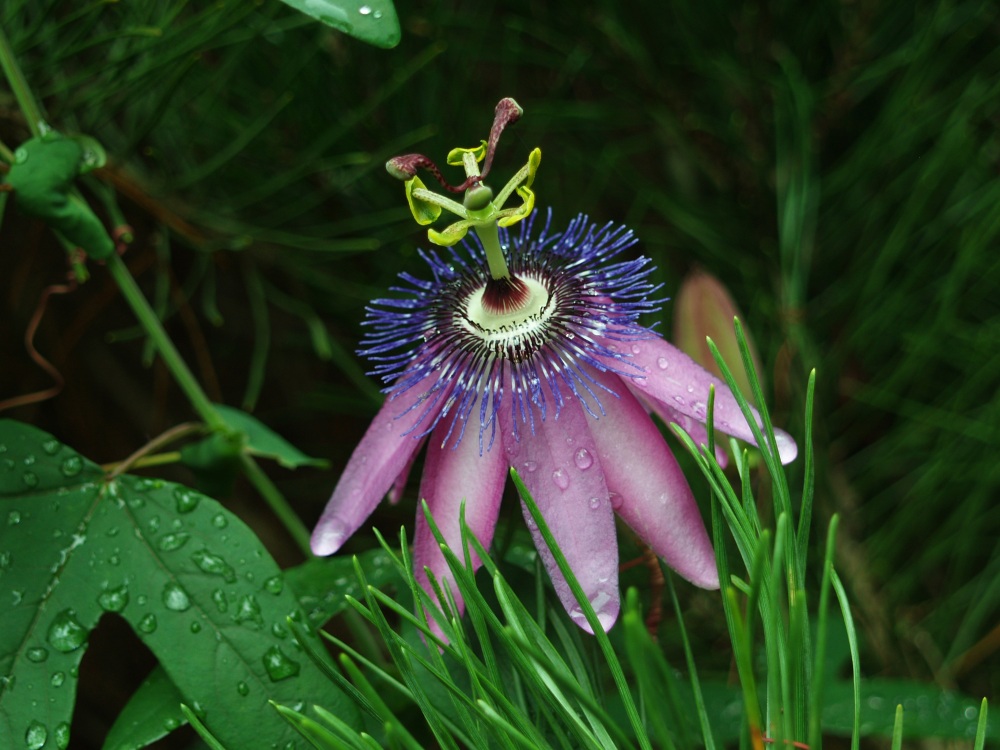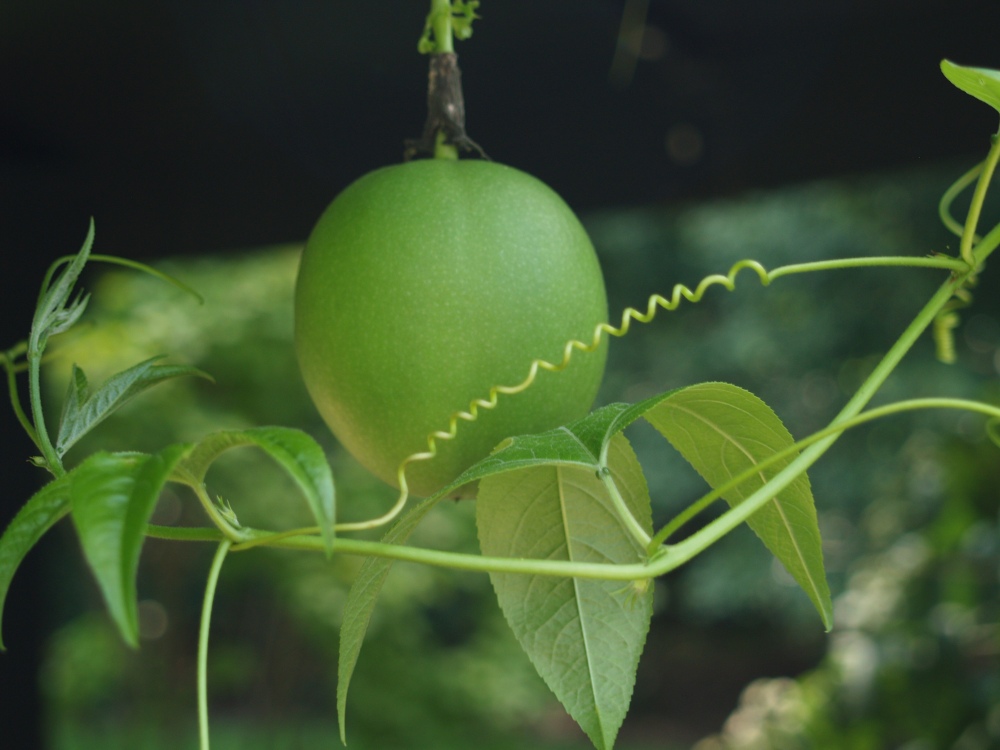The hybrid purple passionflower vine (below) perished over the winter. Last year, it grew vigorously to the top of a wrought iron cage and into the neighboring paperbush (Edgeworthia chrysanthus) by summer’s end, and there were many small flowers, but perhaps this spot on the low side of the garden was too wet through the winter. Or, the vine was not cold hardy enough. There are many varieties of passionflower, from ones suited only to the tropics to natives that are dependable to temperatures below zero, and I depended on the supplier’s hardiness information to be correct. In any case, wherever you are purchasing a passionflower, it is prudent to take care to have it properly identified if you are intending it to survive the winter outdoors . 
Two native passionflowers in drier settings are doing fine. The native purple passionflower (Passiflora incarnata, below) returns dependably every year, though after a particularly cold winter it might decide to hibernate until late May before sprouting. After our extraordinarily warm winter and early spring a year ago, the vine broke ground much earlier than is usual, but still it flowered in early August.
This year, with cold temperatures extending far into April the passionflower emerged six weeks later, but it began flowering earlier, in mid July when Japanese beetles were at their peak. It became obvious very quickly that passionflowers are a beetle favorite, so of the initial buds that were set, no flowers fully emerged before they were ravaged. Fortunately, in early August new flower buds are being set, so now that the beetles are mostly gone they should bloom normally.
The native yellow passionflower (Passiflora lutea, above) is not bothered at all by the beetles, though they began flowering just as the beetles numbers declined so I cannot be certain. The yellow blooms are quite small, and I’ve planted the vine on the back side of the large koi pond so that it’s quite difficult to get close to without squeezing dangerously past the butterfly covered Joe Pye weed and balancing on boulders at the pond’s edge. I teeter, wobble, and fall without much provocation anyway, so I’m reluctant to take my chances on too many close ups.
The yellow passionflower vine seems to be nearly as vigorous as the purple, though its stems are smaller in diameter. It is climbing through several hydrangeas and into the ‘Okame’ cherry that looms over head, and I’m unconcerned that the slight weight of the vine will result in any damage to the shrubs or trees that it climbs into. Since the vine dies to the ground each winter it should never become bothersome like the akebia and wisteria vines that I still curse long after they’ve been chopped out.
On occasion, a bloom of the purple passionflower will be followed by a rounded, lemon-sized green fruit. The maypop (above) is edible, though I’ve never been able to tell when the seemingly hollow fruit is ripe to try it. With the second round of flower buds ready to open, perhaps I’ll have another opportunity to test the fruit in another month or so.

I wasn’t sure whether to try growing passion flower… After reading your informative post, I will go for it.:-) Thanks!
Passionflower vine is one of the most easily managed vines as long as you don’t mind it disappearing for the winter and reappearing in mid spring, sometimes after you’ve figured that there’s no way that it’s still alive. Then, once it begins to grow, it grows quickly. Because it dies to the ground there are no problems with it becoming too heavy for its support structure, whether it’s on a lattice, trellis, or climbing through shrubs.
I have what I believe is a volunteer of this plant. I was glad to see your pictures, as no one local was able to tell me what it was. This vine has come and gone for three years and is vigorous. Ours is in a bed with a redbud tree located around our in ground pool. Not sure how it got there, but it really likes it.
You say that it is edible. I popped one of the pods and there is a milky white “seed” inside. Are you sure you can eat it? It’s just too odd for me to have the courage to try.
Any additional information about care, which so far it looks like I can’t even kill it. Our lawn care people thought it was just a weed and sprayed it with roundup and it still came back. This year I’ve guarded it and allowed it to go where it wanted and it’s huge! Climbing up the tree and all of the flamingos in the bed and trailing out onto the deck and up the picnic table. 🙂 My grandkids think it’s alive and that it’s out to get them. Feed me Seymour!
I’m sure there’s a difference between edible and tastes good. I’m certain that the fruit of the passionflower in my garden is edible, but I’m not motivated to taste it.